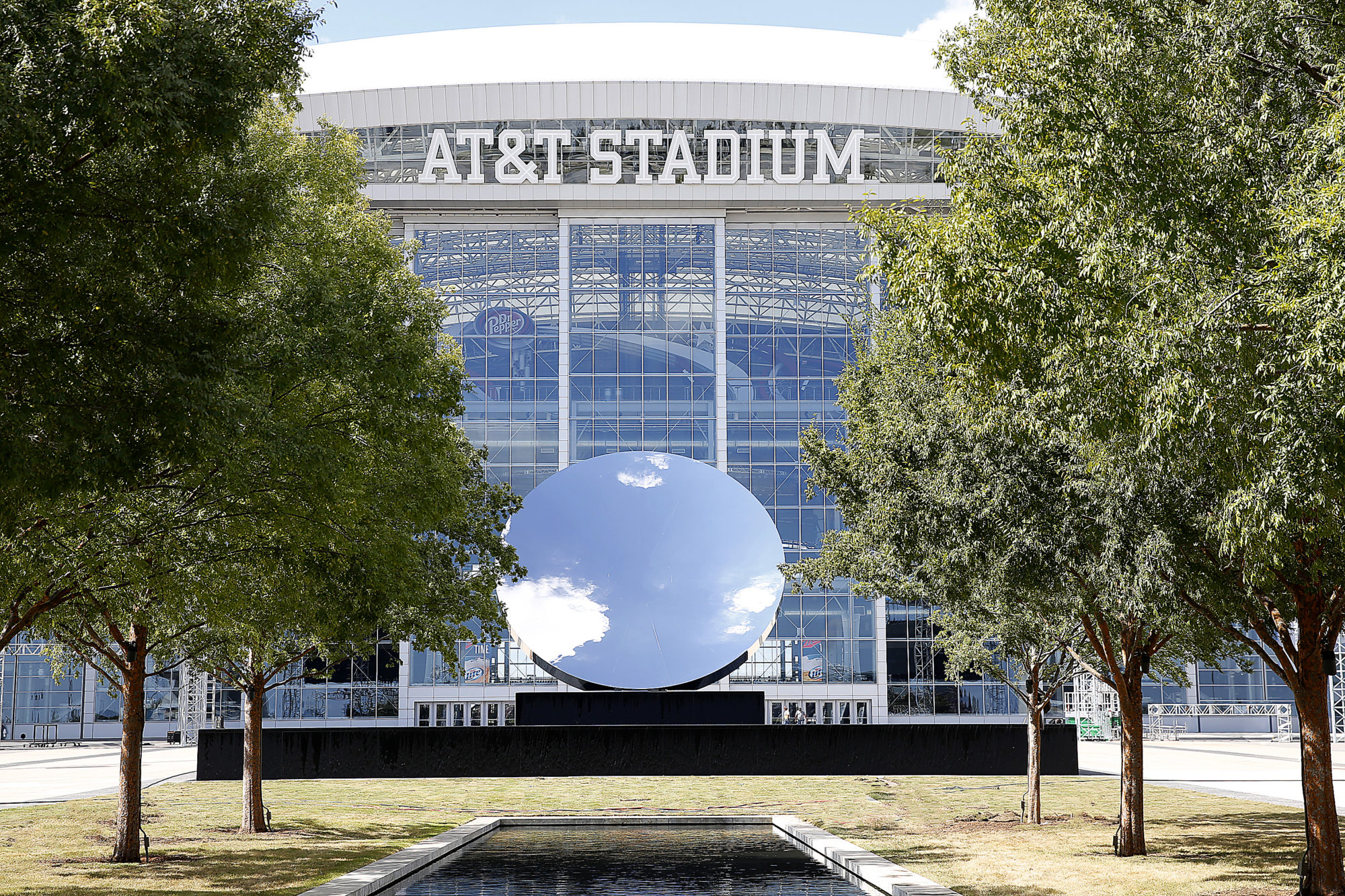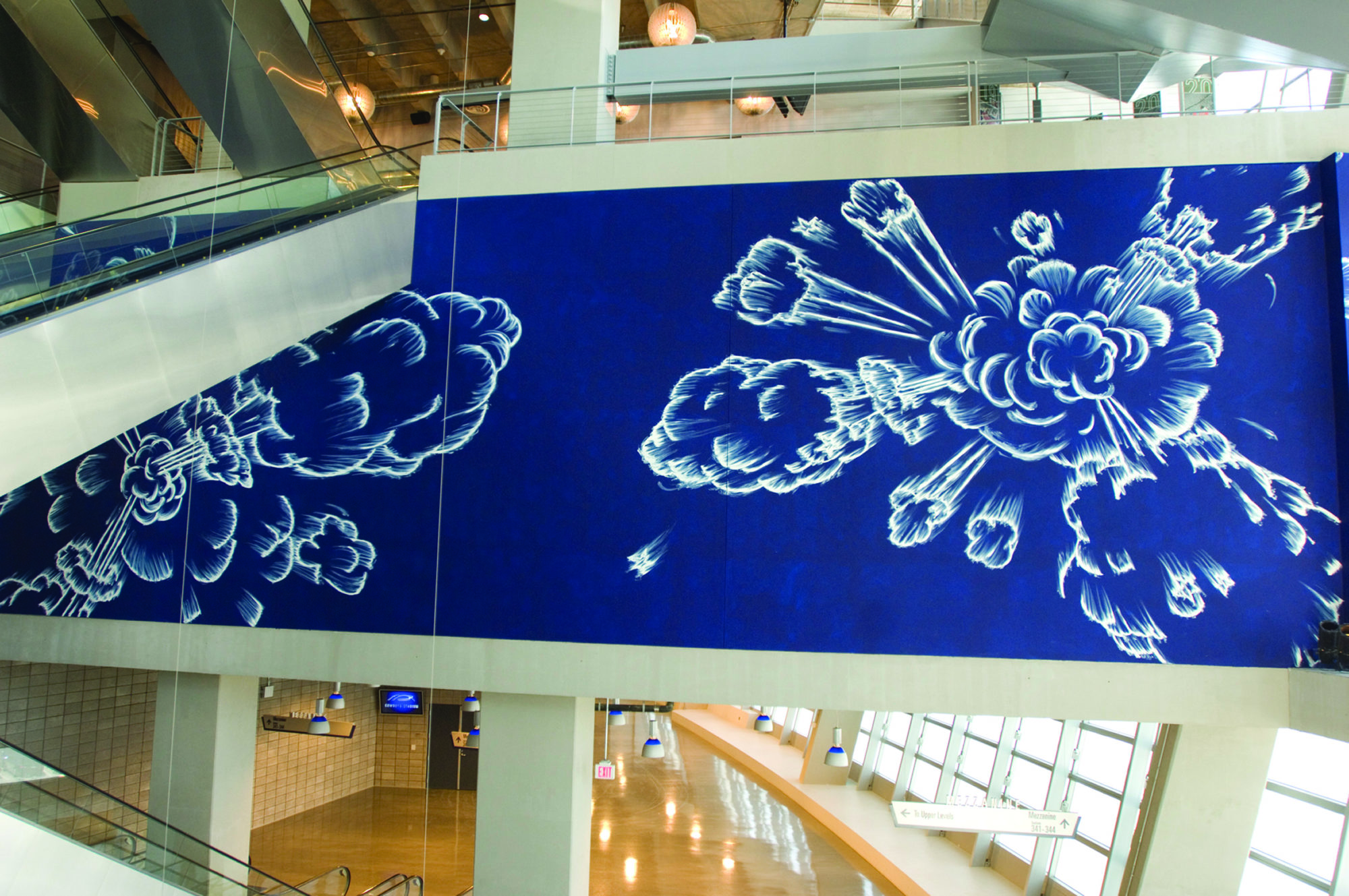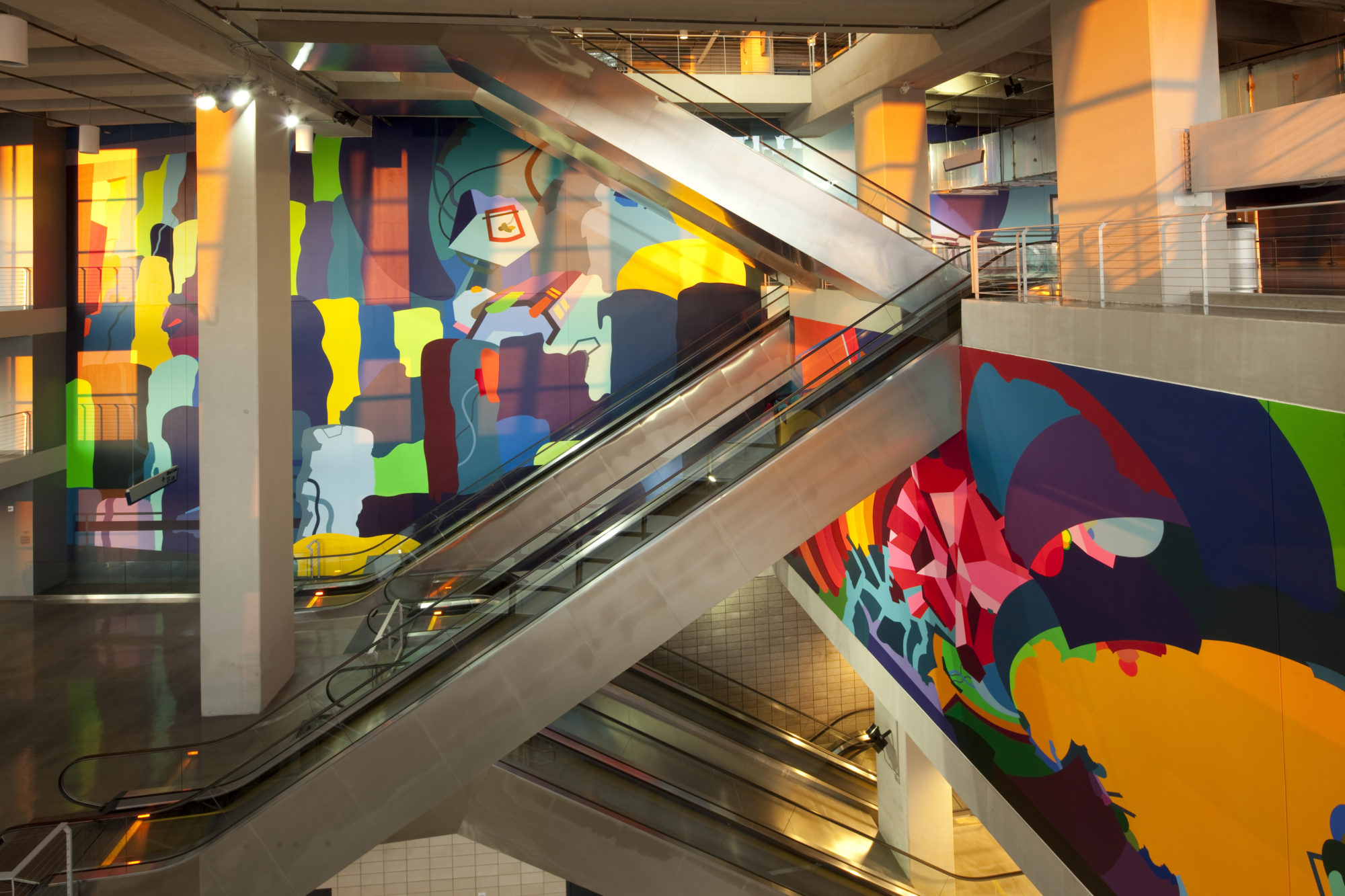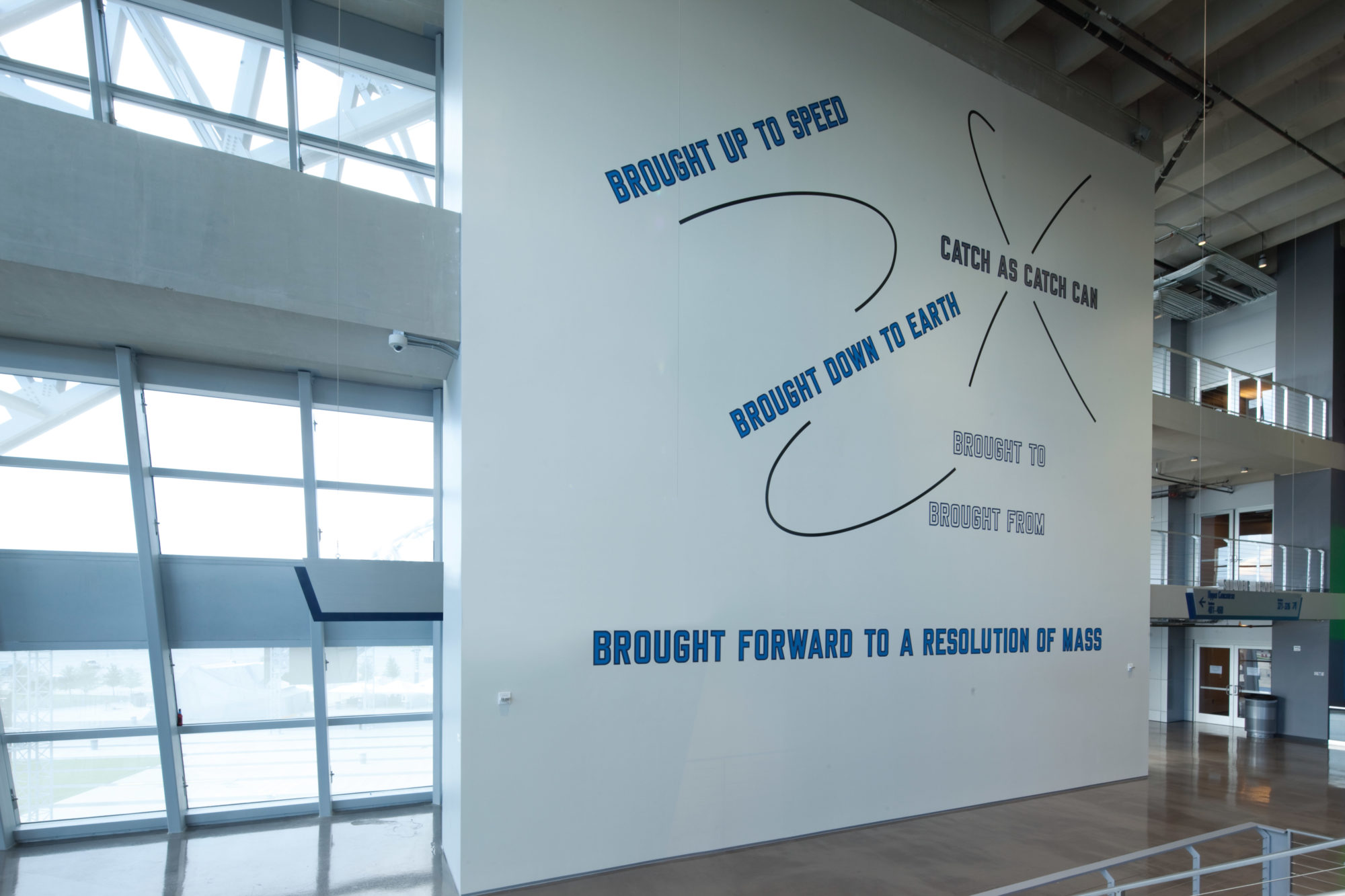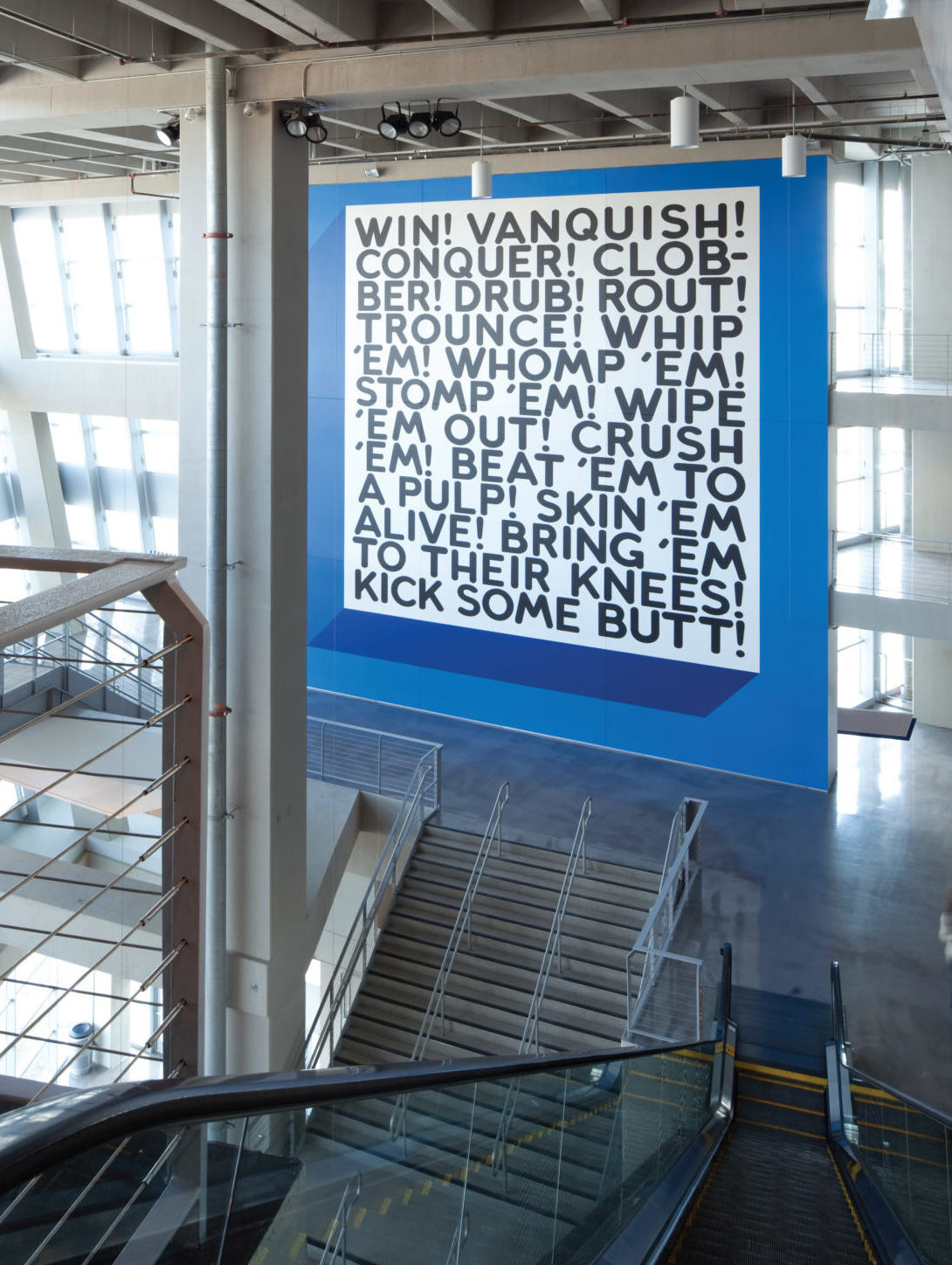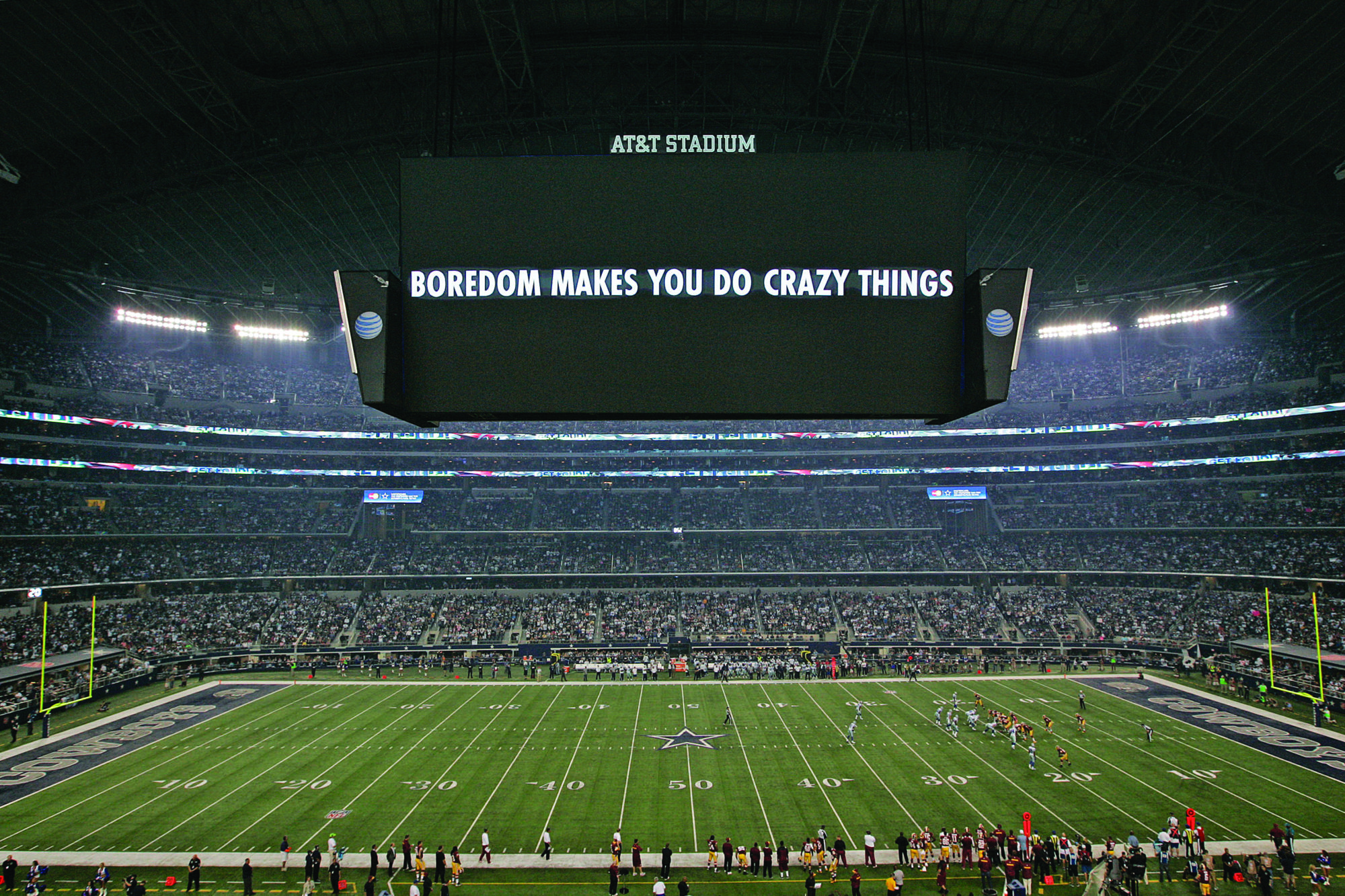
Jenny Holzer, For Cowboys, 2012, electronic Led sign, site-specific commission, AT&T Stadium video board [photo: James D. Smith; courtesy of the Dallas Cowboys]
Fantasy Art Draft
Share:
The AT&T stadium in Arlington, TX, opened to the public in 2009 after almost four years of construction, becoming one of the largest stadiums in the NFL and setting the record attendance for an American football game the same year. The stadium is, of course, home to the Dallas Cowboys; it also contains a world-class collection of contemporary art.
When Dallas Cowboys owners Gene and Jerry Jones decided that the team needed a new stadium, the idea was to enhance the traditional experience of a football game: with a full-spectrum complex for food and entertainment, but also with a robust—and educational—cultural program. They commissioned HKS architects’ sports and entertainment group to design their 3 million square foot, 100,000-spectator capacity stadium, complete with the largest retractable roof in the world, a luminescent 86-foot high glass curtain wall that changes its glow over the course of the day, and a distinctive center-hung video board. Then they set about engaging the spectacular structure with an expanse of sculptures, paintings, photographs, and site-specific installations, designed to occupy every part of the venue: a Daniel Buren is installed above concessions, a Franz Ackermann surrounds a monumental escalator space, and a special commission from Jenny Holzer can be seen on the video board. Achieving all this meant reaching out to Mary Zlot, a San Francisco curator and art advisor who, in 2008, helped to form the Dallas Cowboys’ art council, comprising distinguished members of the North Texas cultural community. The group’s purpose was to acquire and commission works by artists of international renown, and thus to transform the stadium’s public areas into a game-day exhibition space that would inspire attendees with ambitious art, and an ambitious context, well outside of the walls of the traditional museum. The result of their collaboration is a still-growing collection of more than 50 large-scale works, 16 of which were designed specifically for the stadium. The Dallas Cowboys art collection attempts to take the stadium experience beyond utility, and even beyond spectacle—to insight, maybe to awe. On a recent trip to Dallas, Atlanta Contemporary curator Daniel Fuller spoke to Zlot about the challenges and fallout of that ambition; then, he spoke to Gene Jones about her family’s fundamental belief in art, community, and education. Finally, he caught up with Dallas Cowboys legend Phil Whitfield, a life-long fan of the blue and silver who went from security guard at the team’s former Texas Stadium, to the AT&T stadium’s first-ever art ambassador.
Anish Kapoor, Sky Mirror, 2006, polished stainless steel, 35 feet diameter, East Plaza [photo: James D. Smith; courtesy of the Dallas Cowboys]
INTERVIEW: MARY ZLOT
Daniel Fuller: NFL stadiums have begun to host not just the game, but cultural entertainment, food—experiences that are separate from the game, which is why people typically gather at a football stadium. I’ve seen artwork in other stadiums before, but typically the artwork is restricted to luxury boxes and VIP areas not usually accessible to the typical ticket holder. Can you talk to us about the placement of the work?
Mary Zlot: It was always the intent of [Gene and Jerry Jones] that this be an inclusive experience. As you know, it is a beautiful space—beautifully designed, and with great care—and nothing was spared in terms of its appearance, and in making it inviting. And included in that was this idea that this is a venue where people don’t expect to see fine art. It’s almost like inviting somebody into your home—what do people in their homes do when they have big walls and beautifully positioned furnishings? We all want to have things on the wall that are more than furniture and that talk about the idea of creativity. I think that the Joneses wanted to have an art program in this space firstly because they appreciate their audience so much. They wanted the audience to have just the most exquisite and unique experience there. In thinking about the art and those spaces, we talked a great deal, before anything was done, about how do we engage the audience, both in the architecture and in the art.
DF: When I visited, in between all these international art superstars there were a hundred works hanging up by local fifth graders. And—speaking of accessibility—it wasn’t hung up in a closet or off to the side somewhere. It was given a very prominent place that those fifth graders could be really proud of.
MZ: Now they have these school programs, and local children come to the stadium. But in order for anyone to have access to a work of art, particularly contemporary art, people need to have information—an education to inform their way of thinking about the art, a way of looking at it, a way of understanding who created it, how that person works, etc. Not only did we place art—and you know they’re huge spaces, so it’s a big commitment—but we also created an education program. At every single piece of artwork, we have identification plaques that tell you who the artist is, what the medium is, the year it was done, and an entire written description about the artist, about the piece, so that people can actually understand what they’re looking at better. In addition, we have the advantage of great technology. We developed a free app, and it takes any viewer through the entire process of how the collection was formed. It has the Joneses speaking, curators speaking, and it shows artists putting some of the work up. We had this in mind from the very beginning, so we could document what was being done. The art is everywhere—it’s in the areas where people walk up to the least expensive seats; wherever there is a large space, we’ve filled it. The interesting thing about this entire project now? We have never ever had anything damaged. Nothing.
DF: That’s kind of shocking.
MZ: Our big wall drawings come all the way down to the ground, and people walk right next to them. Never has there been any disfigurement, any graffiti, nothing has been scratched or had anything thrown onto it. So if you really provide this kind of environment, I think because it’s so gracious and so beautiful, it makes people very respectful of where they are. And we’ve had such positive feedback about the art because it’s accessible to everybody.
Gary Simmons, Blue Field Explosions, 2009, urethane, pigment, and oil stick on wall, 22 feet by 70 feet, site-specific commission, Northeast Monumental Staircase, [courtesy of the Dallas Cowboys]
DF: Have you gone back much? Not even necessarily to watch the games but just to get in there early and see how people react to the art, see how people look at the art?
MZ: I’m there a lot, and I’m there for games during the season. And usually, before a game, there are people out on the plaza that are completely interacting with the Anish Kapoor, taking selfies. It’s just embraced in such a nice way. People love Mel Bochner’s Win!, which is all verbiage, and there’s a lot of picture taking around that. We had thought, and I think it’s true, that the works would help people identify certain areas to meet. They may not say the name of the artist or the piece, but it becomes an identifier. And so people get there and look; they are curious. And of course you can figure out what all the artwork is on the app.
DF: I just downloaded the app a couple [of] weeks ago. It’s incredibly comprehensive and easy to use. I was sort of surprised when I typed “Dallas Cowboys” into the iTunes app search bar—I figured there’d be a hundred different apps for the Dallas Cowboys. And there are, but the Dallas Cowboy Art Collection was right on top of the list. So it seems like a lot of people are using it … unless it’s some sort of algorithm and they know I’m looking for art or something!
MZ: We are very proud of it. I remember, Daniel, that when you got there, you couldn’t believe what you saw. It happens so often that we get feedback saying, “I just went, I just saw, I can’t believe it! How did this happen, who did [this]?” This wouldn’t happen without Gene. Gene’s the driver here. She really has headed this program and done a fantastic job. I think people are always curious, “What were you thinking, how did this happen?” The Cowboys go all over, and she travels to every game—the family goes to every game—so she’s seen a lot. And it’s an unbelievable experience to go into a stadium and be confronted with museum-quality art. People are quite impressed with it, and very excited.
DF: The Dallas/Fort Worth area—and obviously the stadium is right … between the two—has incredible museums; but between the Dallas Museum of Art, Dallas Contemporary, the Modern Art Museum of Fort Worth, the Kimbell Museum of Art, The Nasher Sculpture Center … it’s such a rich region for art. Did you think about how the stadium could be in dialogue with or fill in gaps left by museums in the area?
MZ: No, that wasn’t our intent. When I formed this art council, on it was the senior curator at the Dallas Museum [of Art] and the senior curator at [the Modern Art Museum of] Fort Worth—at the time it was Charlie Wylie and Michael Auping. Charlie has gone on to the Santa Barbara museum, and now Gavin Delahunty represents the Dallas museum on our art council. We work closely with the museums, in that we have had their groups come visit, and the Joneses have spoken at the museums about this in terms of their educational programming, etc. But the idea was to place really great art, and if it went along with what’s in these collections, fine; if it went along with somebody who was coming to do something, fine. For instance, with Jenny Holzer, early on we wanted her to do our first video piece, and she did, and then it turns out a year and a half later she had a show at Fort Worth. It was probably on the docket, but that didn’t even come up—I don’t look ahead and see who’s showing what and then propose it. We’re very independent.
Franz Ackermann, Coming Home and (Meet Me) At the Waterfall, 2009, acrylic on wall, dimensions variable, site-specific commission, Southwest Monumental Staircase [photo: Todd Eberle; courtesy of the Dallas Cowboys]
DF: The scale of so many of the installations is monumental—and monumental projects seem to lend themselves to these sort of “win big/lose big” sort of situations. Do you have any fun or harrowing installation stories that you could share?
MZ: To have these works installed is daunting, because of the height of so many of them. Have you met the artist Gary Simmons? He’s a fantastic guy—and big; he’s, like, six-three. He had to get up on this cherry picker, and the way he works is he paints, then while it’s wet he actually uses his arms to create that smear. So it’s a very physical thing. But he’s afraid of heights! So we had to talk him into doing this, and we went out and bought all kinds of apparatus to strap him in so he’d feel okay about it. Jim Isermann, who created a work in a ramp area, was using vacuum-processed plastic. It turned out we couldn’t put the mechanical cherry picker on the [adjacent ramp, which] couldn’t hold the weight, so he had to do this installation with an arm that went all the way from the ground, which is a big distance, up the wall. So there were some real challenges in trying to install this. We also had some challenges in some places where walls had to be reinforced because whatever we were putting up there had more of a pull than we had anticipated. We had a fantastic construction group, and they became very engaged in the art process. Instead of being like, “Oh my god, this is so much more work,” they really loved working with the artists. They just did everything they could to facilitate the artists’ needs.
DF: One thing that was impressive to me, too, was being surprised by the artist list. You look at it and you think, the Kapoor—which is stunning—makes perfect sense for a stadium like that and an art collection like this. Then there are folks with somewhat local ties, with Trenton Doyle-Hancock being from Texas. But the name that popped out at me when I was first going to see the collection was Wolfgang Tillmans’. I was thinking, “What do they have by Wolfgang Tillmans?” It’s not a risqué piece, but at the same time his work can be risqué. There must be people that go to the stadium and want to Google artists and get to know them more. Was it a concerted effort to indirectly challenge folks?
MZ: With the Tillmans, it’s one of his abstract works, where he uses technology. We didn’t put a piece in that was challenging in the way you’re suggesting. Your question never occurred to me, to tell you the truth. He does other kinds of work that are of his contemporaries—he basically photographs the contemporary world. Wolfgang Tillmans is one of the most important photographers in the world. So the question is about what level of artists are we putting in? We came across that piece when Andrea Rosen had it in her booth in Miami a couple of years ago. I was there with Gene Jones and [daughter] Charlotte Jones Anderson, and we were all taken aback, like, this is so beautiful. It’s so fantastic, this would be a fantastic thing for the stadium to own, and we’d be so proud to have a work of Wolfgang’s. Nothing else occurred in my mind.
Lawrence Weiner, BROUGHT UP TO SPEED, 2009, vinyl decals on wall, 38 feet 2 inches by 33 feet 3 inches, Southwest Monumental Staircase, site-specific commission [photo: Todd Eberle; courtesy of the Dallas Cowboys]
INTERVIEW: GENE JONES
Daniel Fuller: As sports fans, we have watched the traditional football game shift towards multi-faceted entertainment—now, attending an NFL game might be an immersive cultural encounter, a life event. Can you tell us about the initial decision to add art to the Dallas Cowboys experience?
Gene Jones: We truly wanted the stadium to be more than a place to watch a football game or concert. It’s a fabulous venue for those events, but we wanted to offer other experiences within the building. And our decision to collect contemporary art is because it complements and interacts with the architecture of the stadium. We have tried to make selections that are accessible and approachable for all the people who visit AT&T Stadium, and also now our new headquarters, The Star, in Frisco, Texas.
DF: Which do you remember more vividly: Your first football game or your first visit to an art museum?
GJ: For our family it would be a football game, as we’ve been a part of the Dallas Cowboys for 27 years. But since we’ve moved to Dallas we have become more involved in the art community with the Dallas Museum of Art, the Modern Art Museum of Fort Worth and the Nasher, to name a few.
Jerry and I have collected art over the years for our home, but nothing on the scale of this collection or with this much contemporary art. But our youngest son, Jerry Jr., has collected art for quite some time. Through our experience with the Dallas Cowboys Art Collection, Charlotte and Stephen have started to acquire works for their homes, which is exciting to see because that interest is directly related to this collection and what we have learned throughout this process from our art advisor and art council. Even our grandchildren have all become interested in collecting art. It’s truly been a rewarding experience for our entire family!
DF: I was really fascinated by the student art program at AT&T Stadium. The day I visited, we walked through this remarkable collection of international art superstars, but there were also a hundred works by local fifth graders on view. It was tremendous.
GJ: When the Dallas Cowboys Art Collection was established we began offering educational tours to individuals and school groups throughout North Texas. On average we host approximately 50,000 participants and roughly 800 schools per year. But just this past year we developed a pilot program with the Arlington Youth Foundation [for which] we hosted the fifth grade classes throughout the entire school district. They were able to experience the art firsthand and interact with it through Phil Whitfield, our art ambassador, and through Brill Garrett, [wife of] our head coach, Jason Garrett …. At the conclusion of the year they were challenged to create an art project based on their experiences. It was remarkable to see the enthusiasm and excitement from these children in seeing their works on display. And the talent was fantastic!
“…now, attending an NFL game might be an immersive cultural encounter, a life event.”
Mel Bochner, Win!, 2009, acrylic on wall, 38 feet 2 inches by 33 feet 3 inches, site-specific commission, Northeast Monumental Staircase [photo: Todd Eberle; courtesy of the Dallas Cowboys]
INTERVIEW: PHIL WHITFIELD
Daniel Fuller: Before becoming the public face of the art collection you hadn’t worked with art or artists. Where does your excitement and enthusiasm for the art come from?
Phil Whitfield: When I started working with the artists I did not have any experience with art. Spending time with the artists during their installations and helping them behind the scenes with whatever they needed at the time has shown me another part of culture I had not been exposed to before. From all my experiences here at AT&T Stadium, I’ve learned to look at things differently … even the paint color of my walls and the pictures I hang in my home. It’s given me a new perspective on life. And this adventure has given me the opportunity to participate in and attend gallery exhibitions, artist openings, operas, and other cultural events that I would have never even considered in my life before the Dallas Cowboys Art Collection!
DF: Having worked with each of the artists during their time at the stadium, do you have a piece that is your favorite to talk about with visitors?
PW: I cannot say there is a “favorite.” With Franz Ackermann, the fact that he was a former soccer player, and that when his soccer career ended from an injury he made the journey to become an artist, truly inspired me. And there is Gary Simmons. I bonded with Gary during his installation when we discovered he was afraid of heights and had to climb a tall scaffolding to install his work …. I, too, am afraid of heights, but I strapped on a harness and climbed the scaffolding with Gary to let him know it would be okay! I have some great memories of the time I’ve spent with all of the artists.
Daniel Fuller is the curator at the Atlanta Contemporary.
